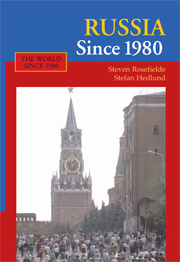Book contents
- Frontmatter
- Contents
- List of Figures, Tables, and Boxes
- Acronyms
- Timeline
- Preface
- Acknowledgments
- Introduction
- PART I RUSSIA BEFORE 1980
- PART II GORBACHEV
- 3 Pandora's Box
- 4 Blindman's Bluff
- 5 Squalid Superpower
- PART III YELTSIN
- PART IV PUTIN
- PART V ADVANCE AND RETREAT
- PART VI PROSPECTS
- Conclusion
- Glossary
- Bibliography
- Index
- References
3 - Pandora's Box
Published online by Cambridge University Press: 05 June 2012
- Frontmatter
- Contents
- List of Figures, Tables, and Boxes
- Acronyms
- Timeline
- Preface
- Acknowledgments
- Introduction
- PART I RUSSIA BEFORE 1980
- PART II GORBACHEV
- 3 Pandora's Box
- 4 Blindman's Bluff
- 5 Squalid Superpower
- PART III YELTSIN
- PART IV PUTIN
- PART V ADVANCE AND RETREAT
- PART VI PROSPECTS
- Conclusion
- Glossary
- Bibliography
- Index
- References
Summary
The West's panacea for Stalinism and the inefficiency of the Soviet planned natural economy was liberalization, which many were convinced would steer the Kremlin to democratic socialism and perhaps free enterprise. Moscow for whatever reasons liberalized, as described in Chapter 2, but didn't reach the promised land. Democratic socialism, free enterprise, and multiparty democracy remained forever on the bright, shining horizon, until Mikhail Gorbachev initiated his destructive reforms.
It is difficult to judge whether he had a coherent agenda. Like his predecessors, Gorbachev was prone to making grandiose gestures that committed him to little. In this spirit, Stalin had constitutionally proscribed inhumane punishments in 1936, the year before the NKVD (Stalin era Soviet secret police) archive indicates 353,000 people were executed as enemies of the people. Democratic Market Communism also may have been mainly for show, with one crucial difference. Gorbachev and his entourage seem to have had a venal hidden agenda that caused things to get out of hand quickly. They talked prudently about supplementing Lenin's natural economy with yarmaki (bazaars), cooperatives, leasing (arenda), enterprise worker councils (trudovye kollektivy), increased managerial autonomy, entrepreneurship, foreign joint ventures, and better prices but knowingly allowed this to become a vehicle for insiders to seize control over enterprise revenues, materials, and assets.
For many economists, this was a necessary evil. They argued that private property was essential for market efficiency and didn't fret about how it was acquired because assets would eventually pass into honest hands.
- Type
- Chapter
- Information
- Russia Since 1980 , pp. 38 - 55Publisher: Cambridge University PressPrint publication year: 2008

